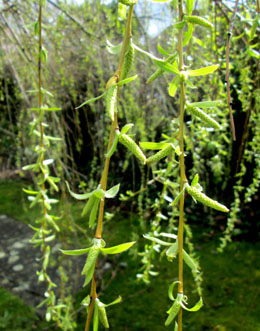The curly willow is really a very curly tree, or at least, its branches are. Its centerpieces look really interesting, especially in a floral arrangement.

The curly willow is native to northwestern China, and is botanically known as
Salix matsudana. It is named in honor of the Japanese botanist, Sadahisa Matsudo. It has many other names too; Corkscrew willow, Hankow willow, Peking willow, Dragon's Claw, etc., all because of its unusually-shaped, twisting branches and stems.
Characteristics
- It is medium to large-sized, deciduous, growing up to 20-40 feet tall with a spread half its length.
- It is a fast grower, but very short lived.
- It grows upright with its branches spiraling all around it.
- It bears narrow, light green-colored leaves, and in spring, it bears catkins (flowers) with the male and female flowers on separate trees.
- It is dioecious, and the flowers are borne around April - May, with a pale yellow color.
- It is a popular ornamental tree for landscaping, not for its foliage or flowers, but its twisted and contorted branches.
- It can easily be propagated from softwood, semi-hardwood, or hardwood cuttings.
- Except in winters, it can be easily planted anytime of the year.
- It does well in soils whose pH balance is 5.6 to 7.8, and can thrive in full or partial sun. It enjoys soil that is moist, so make sure there aren't too many gaps between its watering frequency.
The Bonsai
A popular
cultivar, '
Salix matsudana Tortuosa', is often grown as a bonsai tree. It can also be grown in pots and containers, and its multiple branches can be pruned into a single trunk. It looks amazing, different
cultivars come with different foliage color. Even as a bonsai or a container plant, maintain the soil pH balance. It does not have a long life, besides this, its branches are not very strong, and are susceptible to breakage. While planting, avoid the wind path. Even its roots are small, so are affected by strong winds. Besides this, the bark is very thin and keeps falling off adding to the garden litter. It is vulnerable to aphid, moth, and sticky black larvae attack. It can eat into leaves, and at times into young stems too. Borer is another pest, that can drill holes right into the trunks, and can even kill the plant.
Branches
The branches of this tree make for attractive center pieces. As they are slender, they can be twisted to suit a particular design. Using these flexible branches, one can make floral arrangements. And if you do not want to use them in a floral arrangement, you can leave them just the way they are, bare, for an extremely dramatic effect. Place them alone in a tall vase on a high shelf, on the floor, or around some sculptures or paintings, and watch it accentuate your living room. One can even use the designs for crafts like card making.
Grow a curly willow for its dramatic twisting branches, and enjoy its uniqueness among other flowering trees.






 The curly willow is native to northwestern China, and is botanically known as Salix matsudana. It is named in honor of the Japanese botanist, Sadahisa Matsudo. It has many other names too; Corkscrew willow, Hankow willow, Peking willow, Dragon's Claw, etc., all because of its unusually-shaped, twisting branches and stems.
The curly willow is native to northwestern China, and is botanically known as Salix matsudana. It is named in honor of the Japanese botanist, Sadahisa Matsudo. It has many other names too; Corkscrew willow, Hankow willow, Peking willow, Dragon's Claw, etc., all because of its unusually-shaped, twisting branches and stems.